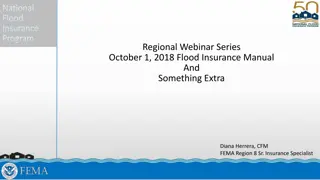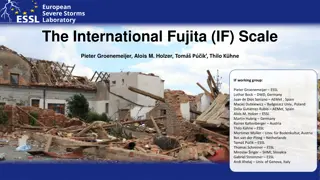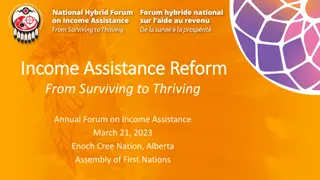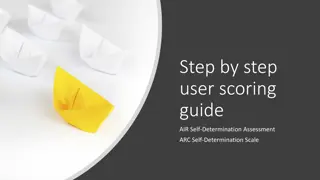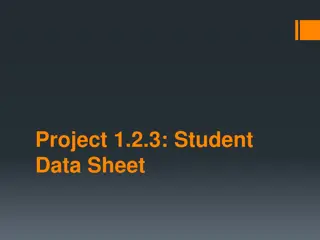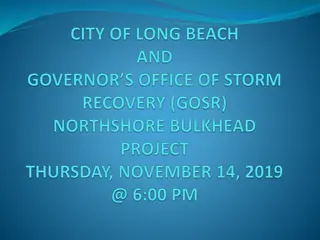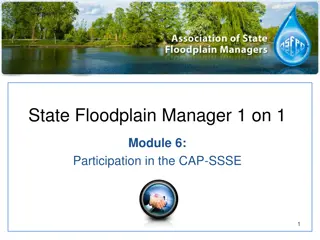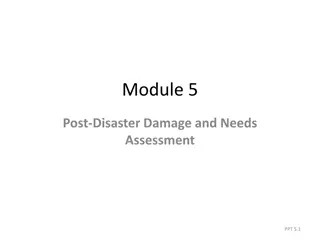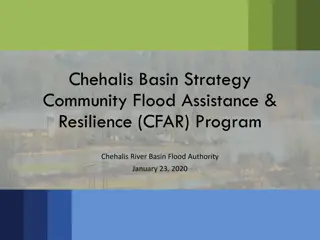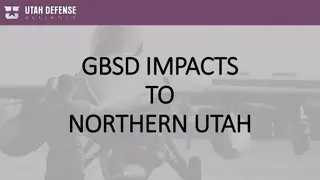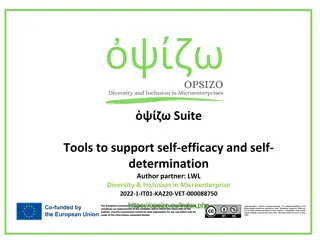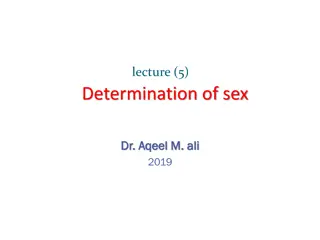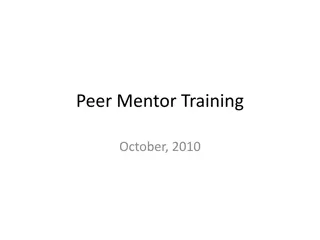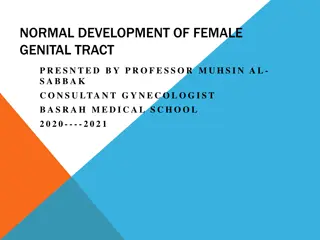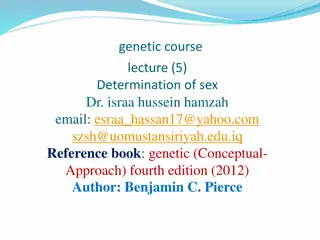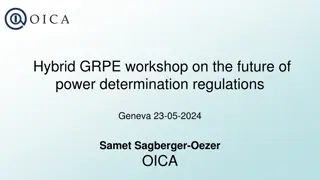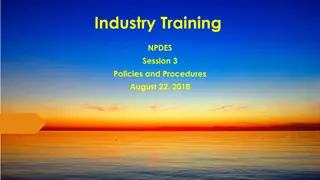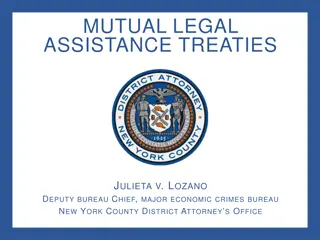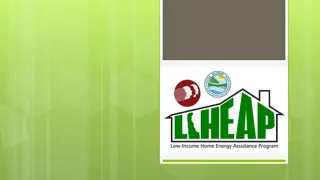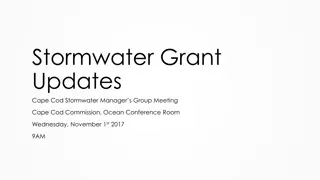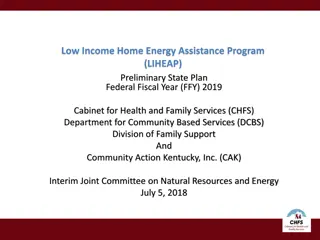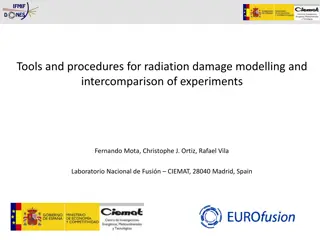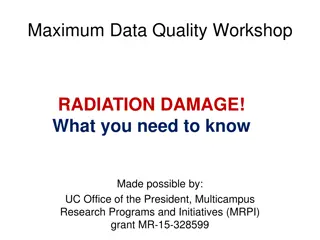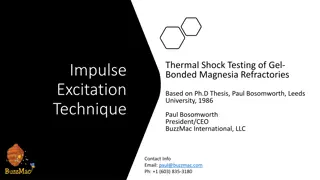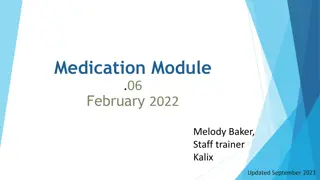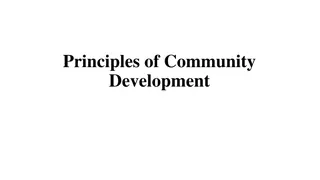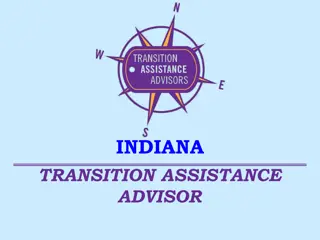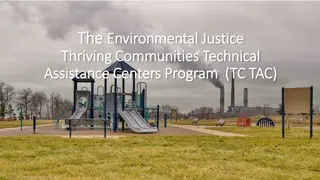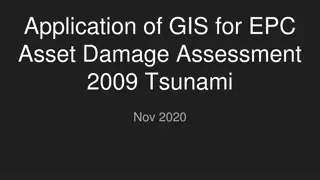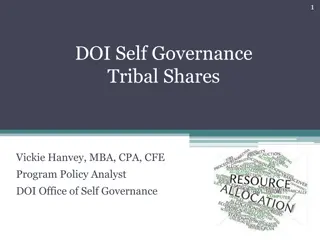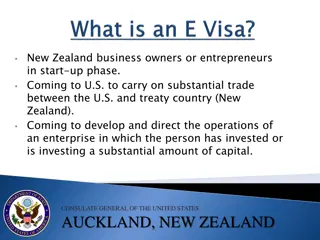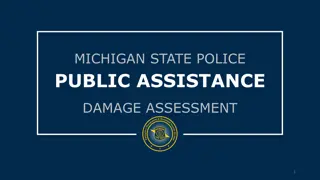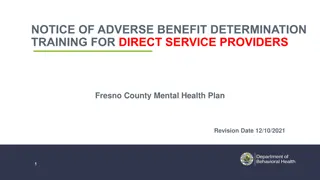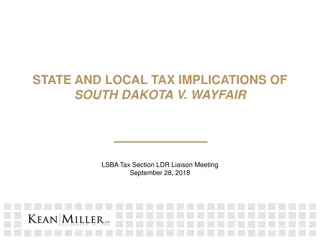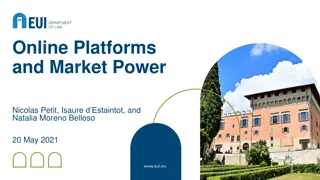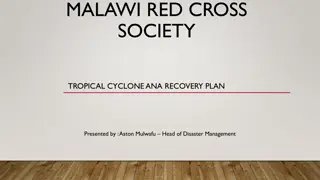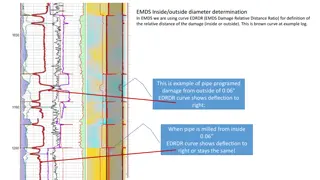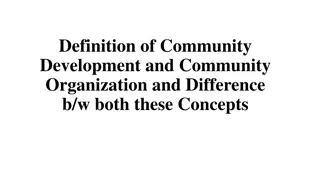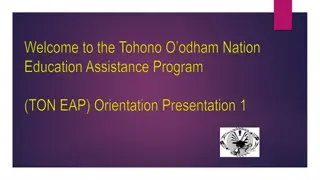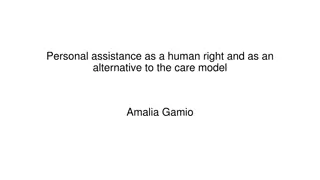NFIP Substantial Damage Determination Assistance and Post-Damage Community Responsibilities
Substantial Damage Assessment is crucial in determining if properties in flood hazard areas have sustained damage exceeding 50% of their market value, requiring compliance with local floodplain management regulations. Communities participating in the NFIP play a vital role in regulating development, issuing permits, and enforcing post-damage assessments. The assessment process involves immediate identification of affected areas, public notices, inspections of damaged structures, and permitting reviews for compliance. It is essential to follow these steps to ensure proper management of substantial damage events.
Download Presentation

Please find below an Image/Link to download the presentation.
The content on the website is provided AS IS for your information and personal use only. It may not be sold, licensed, or shared on other websites without obtaining consent from the author. Download presentation by click this link. If you encounter any issues during the download, it is possible that the publisher has removed the file from their server.
E N D
Presentation Transcript
REQUESTING NFIP SUBSTANTIAL DAMAGE DETERMINATION ASSISTANCE STEVE FERRYMAN, CHIEF OHIO EMA MITIGATION BRANCH JAMES DECKER, SAFEBUILT ALICIA SILVERIO, STATE NFIP COORDINATOR/MANAGER ODNR FLOODPLAIN MANAGEMENT PROGRAM
POST -DAMAGE COMMUNITY FLOODPLAIN MANAGEMENT RESPONSIBILITIES Communities that participate in the National Flood Insurance Program (NFIP) are responsible for: Regulating all development in flood hazard areas depicted on FEMA Flood Insurance Rate Maps (FIRM) Issuing floodplain development permits Enforcing locally adopted floodplain management regulations (based on NFIP minimum requirements), including performing substantial damage assessment
SUBSTANTIAL DAMAGE Substantial Damage Assessment is commonly known as the 50-Percent Rule . The NFIP regulations require that building(s) in mapped flood hazard areas (that have sustained damage from any source)must be assessed to determine if the damage equals or exceeds 50% of the building s market value. If a building in the mapped flood hazard area is determined by the local official to be substantially damaged, it must be brought into compliance with local floodplain management regulations. Cost to Repair to Pre-Damage Condition Pre-Damage Market Value of Building 50%
SUBSTANTIAL DAMAGE ASSESSMENT PROCESS Damage assessment must be performed IMMEDIATELY after any damaging event (flood, fire, wind, etc ). Property owners cannot repair structures until the damage has been assessed for substantial damage. 1) Identify affected areas Tour flood hazard areas immediately - as soon as floodwaters recede. Identify areas where structures have been affected/damaged. Document high water marks in feet above grade. 2) Provide Public Notice Publicize information about local floodplain management regulations/requirements to obtain floodplain development permits. Issue press releases.
SUBSTANTIAL DAMAGE ASSESSMENT PROCESS CONT 3) Initiate inspections of individual structures Conduct inspections of all damaged structures. Inform property owners of local floodplain management regulations & requirements to obtain floodplain development permits. Post notices on damaged structures. Determine whether cost to repair is SD & notify property owners. Report findings to ODNR s Floodplain Management Program. 4) Permitting Review floodplain development permit applications for compliance with local floodplain management regulations. Issue permits for compliant developments.
SUBSTANTIAL DAMAGE ASSESSMENT PROCESS CONT 5) Provide Technical Assistance Property owners will have many questions. Provide technical assistance, informational materials, contact information for additional resources. Identify opportunities to mitigate flood risk. Share information, options, & resources with property owners.
POST -DISASTER Various government agencies & organizations perform various types of assessment after a damaging event. These assessments are not focused on obtaining the information necessary to ensure compliance with locally adopted floodplain management regulations. Community Floodplain Managers are responsible for ensuring that affected structures are inspected for damage, properly routed through the floodplain development permit review process, & evaluated for substantial damage. Depending on the magnitude of a damaging event, the number of qualified community officials & available resources may not be sufficient to perform the required damage assessment immediately after an event. In these situations, communities may consider requesting inspection assistance from the Ohio Building Officials Association (OBOA) Disaster Response Team (DRT).
WHY REQUEST ASSISTANCE FROM THE DISASTER RESPONSE TEAM (DRT)? Community officials can be overwhelmed after a disaster. Damage assessments MUST BE performed & completed QUICKLY Communities may not have enough resources to perform damage assessment before recovery begins Post-disaster assistance can be requested from the DRT to help perform various post-disaster duties DRTs can conduct MANY assessments in a short period of time Completed damage assessment expedites community recovery
DISASTER RESPONSE TEAM (DRT) Comprised of OBOA members, experienced floodplain management professionals, & ODNR Floodplain Management Program OBOA is a professional statewide organization composed of building code officials, whose purpose is to: Foster communication & education between building officials, plans examiners, inspectors, & associated industry members Promote high standards of efficiency in the administration & enforcement of building codes & the development of regulatory codes Provide professional assistance & technical advice to legislative & other governmental bodies in the promulgation & administration of building codes & related regulations OBOA may provide manpower, knowledge, & related equipment to the State, counties, townships, municipalities & other quasi-governmental entities requiring assistance during emergency situations when local resources are deemed insufficient. Participation in DRT by OBOA members or other floodplain management professionals is voluntary. DRT members will undergo annual training on SD requirements & SDA.
HOW THE DRT CAN HELP Preliminary Damage Inspections Initial assessment of damage Assist local officials determine the event scope & means to accomplish recovery. Substantial Damage Assessment Assist communities enforce regulatory standards through inspection of individual buildings & determination if the structure has/has not been "substantially damaged". Follow-Up Inspections for Approval of Construction Assistance with post assessment activity Help community officials with the issuance of permits, conducting inspections of repair &/or replacement work, issuing repair orders, & issuing condemnation orders.
OTHER WAYS THE DRT CAN HELP Field Inspections Outreach /Education Document & survey high water marks. Assist with education on post-disaster requirements. Identify & map damage areas. Operate informational booths or kiosks. Collect photo documentation. Develop handouts or summary documents for citizens. Perform triage on damage structures. Post notices or door hangers on impacted structures Data Collection Mitigation Advice Collect building addresses & map depth-damage data. Provide mitigation program outreach & education. Compile data needed for damage assessments. Gather data needed for mitigation grant development. Permit Processing Drone Reconnaissance Complete damage assessment database & inventory. Perform safety reconnaissance for the community Assist with damage assessment notifications. Collect aerial imagery of flood damage. Assist local staff with post-event permit processing.
ROLES - STATE Ohio Emergency Management Agency (Ohio EMA ) Coordinate hazard event response, recovery, mitigation & preparedness efforts for the state Receive mission requests from local EMAs for SD help, & coordinate with appropriate resource agency Implement recovery & mitigation programs to help pay for SD determination process & repair damaged structures Ohio Department of National Resources (ODNR ) May request mutual aid from OBOA on behalf of participating political subdivisions (working in coordination with Ohio EMA). Provide technical assistance to communities for administration & enforcement of floodplain regulations for SD/SI. Offer disaster training opportunities when appropriate.
ROLES - COMMUNITY Requesting Community Jurisdiction who has suffered damage from a hazard event. The requesting community has requested assistance in accordance with the Memorandum of Understanding (MOU) & supporting guidance. Assisting Community Jurisdiction offering to provide assistance to the requesting community in accordance with this MOU, the Agreement to Provide Assistance included with this MOU & the Manual Prepared by the Committee.
REQUESTING DRT ASSISTANCE - OVERVIEW The Community Floodplain Administrator completes a written request for assistance with substantial damage field inspections to the County EMA Director. The County EMA Director forwards the request for assistance to the State Emergency Operations Center (SEOC), where a Mission/Resource request will be submitted to ESF-3. (Emergency Support Function-3 (ESF-3) is the Engineering & Public Works component of Ohio s Emergency Operations Plan.) The Mission will be accepted, & the request will be forwarded to the appropriate agency. The designated OBOA SD Field Inspection Coordinator (responsible for coordinating the substantial damage determination field inspection process) will be contacted. The OBOA SD Field Inspection Coordinator maintains a database of inspectors trained to conduct SD field inspections. The OBOA SD Field Inspection Coordinator will begin contacting inspectors to determine availability for assignment. Volunteer inspectors will be assigned to communities based on the prioritized need. ODNR s Floodplain Management Program will monitor the status of OBOA SD field inspections until all missions have been completed.
LOGISTICS Where are Inspectors being deployed? REQUESTING community supplies: Community? Maps of community & affected areas Damage estimation materials/tools Prepare necessary materials, supplies, resources & information for Inspectors Damage Estimation Field Worksheets Credentialing Overnight accommodations Fuel / Mileage Costs What do Inspectors need to bring?
REQUESTING COMMUNITY PREPARATIONS FOR INSPECTORS Informational materials for Inspectors Maps of community & affected areas Overnight accommodations Fuel / Mileage Costs Informational materials for distribution to property owners Relevant information about available resources for residents, shelters, Joint Field Office (JFO), disaster assistance, mitigation options, local debris management, cleaning procedures, filing a flood insurance claim, public meetings, etc Contact sheets for relevant community contacts (Floodplain Manager, Building Department, Health Department, etc ) Community Floodplain Development Permit Applications
HOW TO BE A PART OF THE DRT: Attend 2 annual trainings SD Regulations & Procedures Course (Webinar) 1) NFIP requirements for compliance o Post-disaster inspection procedures o Field Training 2) Perform onsite damage assessment for residential/nonresidential* development o Renew Credentials annually Requires completion of both courses Renew Agreement to Participate * Not all types of nonresidential development will be addressed
MEMORANDUM OF UNDERSTANDING (MOU) Communities REQUESTING ASSISTANCE & PROVIDING ASSISTANCE (i.e DRT Inspectors) must complete the MOU. The MOU: Provides a framework for OBOA/DRT members to coordinate their services & equipment with the appropriate state agencies & organizations [Ohio EMA, ODNR, OFMA, etc ] in support of statewide & local emergency management functions; Purpose (through joint coordination & exercise of the resources of OBOA, Federal, State, & local governments) is to enhance the statewide posture of emergency management readiness for conceivable emergencies. Documents details concerning working relationships, arrangements, resources to be provided, reimbursements, & negotiations for both the requesting & assisting communities.
DRT RESPONDER QUALIFICATIONS 1) Be knowledgeable in the building code enforcement industry by holding any certification issued by the Ohio Board of Building Standards (Building Official, Plans Examiner, Inspector, Permit Technician); holding the duties of the local floodplain administrator; or holding the duties of a local property maintenance inspector. 2) Providing signed documentation from the responders' jurisdiction of a MOU between the municipality & OBOA. The MOU will contain language that provides protections to the responding employee following the statewide EMAC procedures & IMAC procedures. 3) Provide verification the responder has attended damage response training.
DISASTER RESPONSE & RECOVERY ACT (DRRA) 1206 FEMA Policy FP 204-079-01 Building Code and Floodplain Management Administration and Enforcement eff. 11/1/2020 Intent is to provide communities with the resources needed to enforce floodplain regulations by conducting SD determinations up to 180 after the disaster declaration date Eligible work includes: Building code administration Code enforcement Floodplain Management Ordinance Administration & Enforcement Eligible costs include but not limited to: Only overtime for budgeted employees & straight time & overtime for extra hires Other costs for extra hires or contracted support including: travel, accommodations & per diem Costs associated with EMAC reimbursement according to PA guidance
SDA WORKGROUP - MOVING FORWARD Finalized ODNR SDA Manual Onsite SDA Training in June 2022 for OBOA DRT (PILOT) Example MOU for OBOA/DRT Assistance SD/SI Resources Webpage on ODNR Floodplain Management Program s Website Onsite SDA Training for Community Officials Annual Trainings for DRT & OBOA Participation in ASFPM Disaster Assessment Response Teams (DART) PILOT Project



